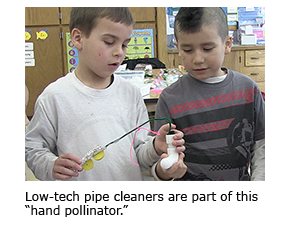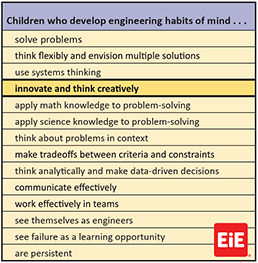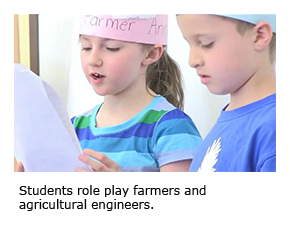In college I had a biology professor who insisted you don’t need fancy lab instruments to do real research, just duct tape and baling wire. He challenged us to make our own research tools, and the results were pretty creative: one classmate who wanted to compare the toughness of different tree leaves made a “puncture-o-meter” out of rubber bands and a sharpened paper clip. 
Young children love this kind of tinkering and problem solving. Check the EiE Video Snippet below to see the creative ways one group of first graders solved the design challenge from the EiE unit “Best of Bugs,” using materials like pipe cleaners and pompoms to engineer a device for pollinating flowers by hand.
Kids Can Learn to Be Creative
The new Next Generation Science Standards make repeated references to creativity—and no wonder. The ability to think flexibly and generate or recognize new patterns and relationships is essential in both science and engineering. (Did you know the root of the word “engineer” is the Latin ingenium, meaning ingenuity or cleverness?)
It’s tempting to think of creativity as a gift that only some people are born with, but researchers who study creativity conclude it’s not a trait, it’s a process . . . and it can be taught. They also find that creativity is a socially facilitated phenomenon. Faced with a complex problem, people who work in groups have better success than people who work alone.
Teaching Creativity
At EiE, we consider creativity to be an “engineering habit of mind”: a way of thinking that students develop when they engage in inquiry-based engineering activities. The EiE Classroom Video collection is packed with scenes of real teachers in real classrooms using strategies that promote creativity. 
One key strategy is to actively expect your students to come up with new ideas. You can encourage them to go beyond their first answers, and model this way of thinking by sharing your own ideas and how you came up with them. Have students work in groups to brainstorm; often, they’ll combine elements from different ideas to arrive at a strong solutions.
Set the tone for these brainstorming sessions. When the new ideas start flying, they should land in a judgment-free zone, where the motto is “No idea is a bad idea.” Instead, be a cheerleader for creative thinking. Celebrate novel ideas even when they don’t lead to successful solutions.
Ask the Right Questions
While it’s important to avoid criticizing or correcting your students’ ideas, it’s equally important to question their assumptions. Asking “how” and “why” encourages students to think deeply about their answers, draw own conclusions, and move toward asking these questi ons on their own.
ons on their own.
One really effective way to spark creativity is through role-playing. Ask students to take on the identity of a person in a story or scenario who is trying to solve a problem. We include lots of these role-playing activities in EiE lessons. For example, the unit “A Slick Solution: Cleaning an Oil Spill” includes a lesson where students play the role of environmental engineers who are hired by a small town to find the source of pollution in a local pond.
Teaching creativity intersects with the engineering habit of mind of “agency.” In this case, developing agency means helping children to see themselves as engineers. Check out the Video Snippet in this EiE Blog post to see a teacher whose skillful use of the question “why” prompts her students to express confidence in their engineering abilities.
Engineering is Elementary is a project of the National Center for Technological Literacy at the Museum of Science, Boston.








